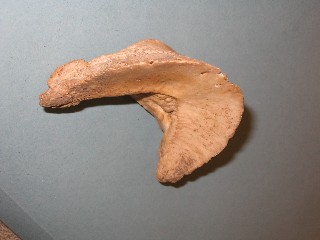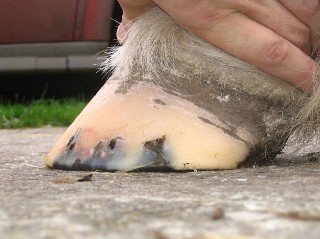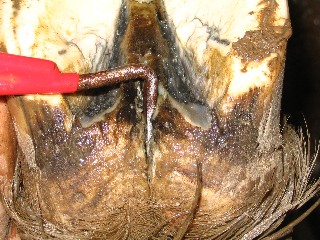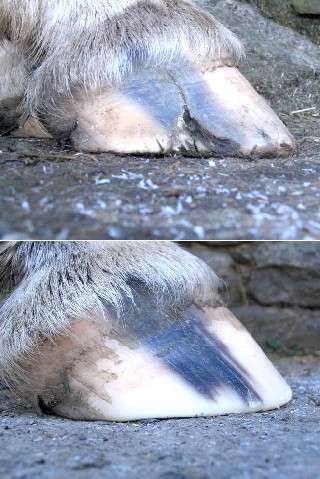Last update: November 2019
This is the text of a talk I was asked to give at Your Horse Live 2008. I’ve added some photos to illustrate a few of the points.
I’m want to talk about some of the things you can do help your horse have healthier hooves. But first, I should probably explain a bit about what I do as an Equine Podiatrist (or EP for short).
Put simply, I’m an expert in the health of the horse’s foot. That means not only being able to trim hooves, but also having a good understanding of the many factors that can affect the health of the foot – things like infection control, turnout regime and diet. I do some work with shod horses in an advisory role but mostly I work with horses that aren’t shod. Some of those are horses that have good feet and so don’t need shoes. Others have problem feet that can benefit from a period of rehabilitation without shoes. As well as trimming the hooves, I work with each owner to try to tweak the horse’s environment so as to get the maximum performance out of the feet. This is often as important as if not more so than the actual trim. The feet don’t work in isolation, so if the horse as a whole isn’t healthy… chances are the feet won’t be either.
Flat footed horses
One thing I often hear an owner say is: ‘my horse wouldn’t cope without shoes because he has flat feet’. Most of us have come across a flat footed horse at some time or other… after all, there are loads of them out there! There are also plenty of people who will tell you that it’s genetic… that we’ve somehow bred whole lines of flat-footed horses. Now if that was the case, you’d expect the main bone in the foot, the pedal bone, to be flat in such horses. But the thing is, I’ve yet to see a flat pedal bone (other than where there is a history of chronic laminitis, which can cause a gradual loss of material from the bottom of the pedal bone). I’ve also never seen a foal with a flat foot.

So what’s going on here? These flat footed horses clearly aren’t born that way. So the flat footedness must develop as they age… but why? Before we can answer that question, perhaps we need to know what flat footedness actually is. If the pedal bone is still concave in these horses, then the problem can’t be with the bone itself.
It turns out there several things that contribute to flat feet, but I want to concentrate on one key one. The horse’s foot has an arch to it, just like a human foot. And just like humans, horses can get fallen arches. This arch is formed by the pedal bone at the front of the foot and a collection of soft tissues at the back. If these soft tissues are weak for any reason, they can gradually collapse (especially if the heels are left too long) and that flattens the foot.
The foot has evolved to land on the heel – the toe only hits the ground a fraction of a second later. It’s no coincidence that the back part of the foot has no bone in it to get jarred on landing – all that soft tissue is there to absorb the shock of impact. In a healthy foot, the heels distort significantly on impact with those soft tissues acting a bit like the suspension in a car.
But if the horse has a fallen arch, the foot can’t absorb shock anywhere near as well. That can lead to lameness and, in some cases, the development of things like arthritis, sidebone, ringbone and even navicular disease.
So if these shock absorbing tissues are so important in the foot, how do we keep them healthy? The problem here is that they don’t have a very good blood supply. They rely on nutrients being forced into them from surrounding blood vessels as the foot moves. The ideal for developing strong soft tissues is lots of impact on hard ground.
The frog is also important here. If the hoof is not trimmed regularly then the heels can grow too long, lifting the frog off the ground. With the frog off the ground, one of the main routes for stimulating development of the shock absorbers at the back of the foot is lost. The frog also needs to be healthy or the horse will start landing toe first to avoid pain there, which causes all sorts of problems not least of which is poor soft tissue development.
As a young horse grows up, it needs movement on hard ground to develop stronger shock absorbers so it can cope with its increased weight. This may give us a clue as to why thoroughbreds have such a reputation for flat feet. The typical racehorse is brought up on a nice soft field and rarely has access to anything harder than a paddock or a nice straw bed. It may not get much exercise either as a youngster. In contrast, the horse’s wild ancestors would have moved 10-20 miles a day on varied terrain, much of it baked hard.
At around 2 years old, long before the foot has fully matured, the typical racehorse gets shod. Those shoes not only lift the frog off the ground a bit, which can interfere with the development of the shock absorbers, but it also reduces the amount the back of the foot flexes each time the foot hits the ground and that slows down soft tissue development too. All that shock absorbing mechanism effectively gets stuck at a 2-year-old level of development. When the horse reaches maturity, it just doesn’t have a strong enough foot to take its own weight and by that point, the heels have generally collapsed and you have a flat footed horse.
Given how many thoroughbreds come out of the racing industry, it’s hardly surprising that the thoroughbred has its reputation for flat feet. Even horses that haven’t come out of the racing industry can suffer the same fate – often because of a lack of access to hard ground as young stock.
Where genetics may come into all this is that some breeds seem to develop better shock absorbers naturally, even in less than ideal situations. Sadly, the thoroughbred doesn’t appear to be one of those breeds!
That said, even an adult horse with poor shock absorbers is not a hopeless case. While it’s difficult to rehabilitate poor shock absorbers in shoes, it is possible to improve it with the shoes removed. A good proportion of my case load is horses with under-run heels and varying levels of heel pain that come out of shoes for a period while the shock absorbers are re-habilitated. In some cases, just pulling the shoes and instigating a gentle programme of conditioning work is enough. In more serious cases, the horse may initially need to be worked in therapeutic pads that help to do the job the shock absorbers are failing to do. In most cases, the horse can continue in work by using removable hoof boots.
But the ideal is to ensure that horses don’t get into this state in the first place, which is why I encourage everyone with young stock to keep their feet regularly trimmed and give them at least some access to hard ground, whether that be turnout in a concrete yard or regular walks around the local lanes.
Diet
Another area that I spend a lot of time on is diet. We’re all constantly bombarded with advice from many sources on how best to feed our horses. A quick tour of the feed company stands at your typical show is guaranteed to leave most horse owners more confused than ever. There seems to be a feed for every situation and a supplement for every problem. All too often though, the feet become an add-on to the feeding programme, always assuming they’re even considered at all. We tend to decide our feeding strategy and then throw an extra supplement or two in on top in the hope of helping those quarter cracks or that poor quality hoof horn.
We’ve all heard the saying ‘no foot, no horse’. Well I want to suggest a different approach to feeding. If the feet are the most important part of the horse, why not make the feet a key part of your feeding programme. I’ve been doing foot-focused nutrition for some time now both with my own horses and my clients’ and I’ve been struck by how often the rest of the horse improves with the feet. It’s not uncommon to see a lazy horse become more forward going, a horse with poor paces gradually develop a more expressive trot or a horse with poor musculature gradually develop muscle in all the right places. Of course, with the benefit of 20/20 hindsight, it shouldn’t be a surprise if a horse with aching feet doesn’t want to move with impulsion, doesn’t want to trot expressively or holds itself tense and so uses all the wrong muscles. These horses often don’t appear lame as such, but that can be because they’re equally uncomfortable on all four feet!
So the obvious question is, ‘what’s a good diet for the feet’? Well there’s plenty of room for more research, but it’s becoming clear that a key part of it is ensuring there’s plenty of fibre in the diet and not too much sugar (or starch). And it’s no co-incidence that we’re talking here about the same high fiber, low sugar diet that’s increasingly being seen as the healthiest option for the whole horse.
If you take horses with foot problems such as recurrent infections, abscessing, thin soles, bruising, etc. and put them on a high fibre, low sugar diet, those foot problems tend to get better – often dramatically so. All my colleagues are seeing this effect time and again.
This kind of diet is relatively simple to do. You need to ensure the horse has access to good quality forage at all times – starvation in any form is counter-productive. Then you cut out grains (or reduce them if the horse is in heavy work), cut out anything with added sugar or molasses and use a chaff based product as the main component of the bucket feeds.
For good doers, this is often enough on its own and, surprisingly, these horses often have more energy when all or most of the high energy feeds are removed from the diet. Poor doers and those in heavy work may need a bit of something extra, although even some of these can hold their weight well on a forage-based diet. Where necessary though, you can add in products that provide extra oil and protein. Oil in particular is a great way of adding energy without adding sugar to the diet. I also find oil- and protein-rich feeds such as linseed a good way of maintaining condition and putting a shine on the coat.
One other thing to watch out for is stomach ulcers. There’s been loads of research recently showing that far more horses have stomach ulcers than we used to think – maybe as many as half of competition horses – and even pleasure horses are not immune. If a horse won’t hold weight on a high fibre, low sugar diet with a bit of oil and protein added, it may be worth trying a stomach ulcer supplement – there’s at least one really good herbal product on the market. If the horse has ulcers, feeding it more may help keep condition on, but it may also wreck the feet – far better to rule out stomach ulcers first.
Foot infections
Perhaps the commonest problem I see in a horse’s feet is infection – thrush and white line disease. Effectively, the hoof is rotting away, sometimes faster than it’s being replaced by new growth. The bugs that cause this rot feed on damaged hoof horn. You can’t escape these bugs as they’re present in vast quantities in all soil. But if the hoof horn is healthy with no damage, there’s nothing for the bugs to eat so the hoof won’t rot.
Ultimately, the dietary changes I’ve already mentioned should make a massive difference to the amount of rot going on, but it can also be helpful in the meantime to use some kind of disinfectant to manage the infection while a healthier, more rot-proof hoof grows down. But you need to be careful here. If you use anything too aggressive (like hydrogen peroxide, hoof oil or iodine), you risk damaging the healthy horn while you kill the bugs. And of course that newly damage horn is the perfect food for the next round of infection.
With careful management of infection problems, really big wins can be had within a few short weeks. One of the commonest causes of a horse constantly losing shoes for example is rampant white line disease. If the bottom of the wall is rotten, it’s hardly surprising if the nails won’t hold. Judicious use of a mild disinfectant as a short term fix combined with a change of diet for the long term can make a massive difference to how the shoes hold. That said, I’ve lost count of the number of times I’ve found that by the time I’ve fixed that problem, the horse didn’t really need the shoes any more.

Thrush can also be a major problem, and yet it’s ignored by so many people. A tiny bit of thrush on the very surface of the frog is not really a major problem and is quite common in the UK with our wet climate. But thrush often eats right into the heart of the frog. I regularly see horses where I can totally lose the hoof pick into the centre of the frog. This kind of damage is painful and will tend to change the whole way the horse moves as it tries to avoid jarring the back of the foot more than it has to. We now think that this is one of the major contributory factors in the development of navicular disease, and yet it’s generally very easy to fix, especially if caught early on.

Infection can really weaken a hoof and is usually involved when you have cracks in the wall. It’s important to deal with any balance issues or problems with the hoof shape when there are cracks, but controlling infection is almost always key to getting the crack to heal.

Barefoot versus shod
Finally, I want to say a bit about the ‘barefoot’ versus ‘shod’ debate. There’s been quite a bit in the horse press recently about the ‘barefoot’ movement… most of it focused on the question ‘can my horse go barefoot’. For me though, there’s a far more important question that needs to be asked first… and that’s ‘does my horse have healthy feet’. If you have four healthy feet, then the question of whether to shoe or not is easy: If your horse is wearing its feet down faster than they grow, then you need to put shoes on. But if there’s enough growth to cope with the wear, then the horse is probably better off without shoes.
I want to make something very clear here. I have absolutely nothing against shoes. I’m very happy to see a horse with healthy feet shod if that’s what it needs in order to cope with the workload. What I do have a problem with is sticking shoes on a horse to mask the fact that it’s not actually sound.
There’s an old farriery saying that you can’t shoe a horse sound. I couldn’t agree more. For me, a sound horse is one that will trot up sound and with a good stride length and correct movement on smooth tarmac or concrete with the shoes pulled. If the horse isn’t 100% sound with the shoes off, putting a set of shoes on is NOT going to make that horse sound, all it’ll do is mask the problem. If there’s a problem with the feet, then you need to sort that problem out, even if that means reducing the horse’s work load for a while. You wouldn’t work a horse with a pulled tendon, so why work a horse with sore feet?
So to sum up, here are my four take home messages to help your horses have healthy feet:
- Give your youngsters a good start in life by trimming their feet regularly and giving them time on hard ground.
- Consider the feet when feeding your horse. Does he really need loads of grains and molasses or would he be better on a high fibre, low sugar diet that will help his feet?
- Look out for infection – don’t just ignore those nasty niffs when you’re picking the feet out. But don’t over-react by reaching for hoof oil and other aggressive chemicals or you risk making the problem worse. And if you can lose a hoof pick into the back of the frog, take that seriously.
- Next time your farrier is with you, try trotting your horse up while the shoes are off. If he isn’t 100% sound on smooth hard ground without the shoes, you have a problem that needs to be fixed – think twice before just putting those shoes back on.